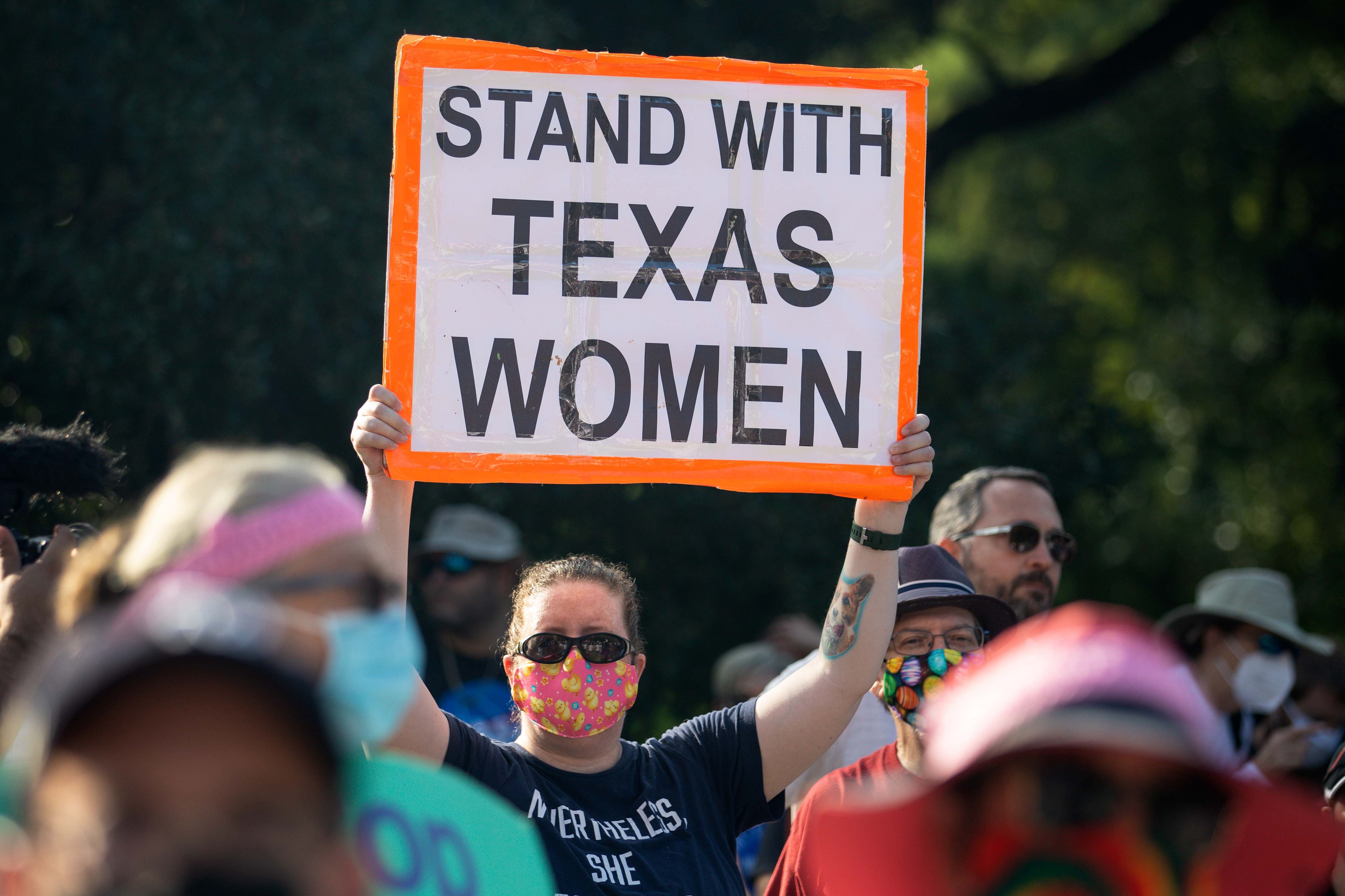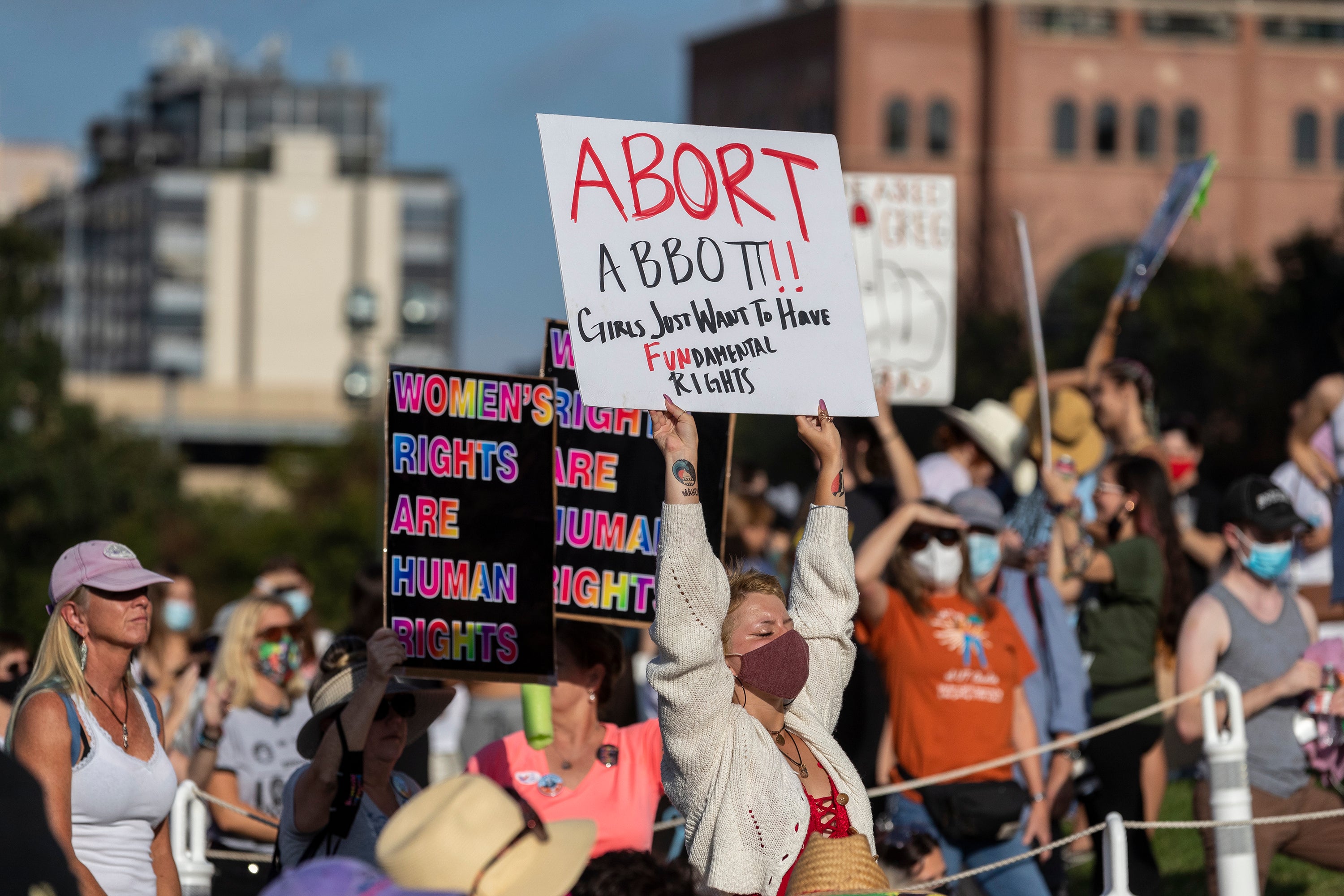Texas patients rush to get abortions as clinics struggle to keep up
Abortion clinics are experiencing the staff shortages prompting longer waiting times
Your support helps us to tell the story
From reproductive rights to climate change to Big Tech, The Independent is on the ground when the story is developing. Whether it's investigating the financials of Elon Musk's pro-Trump PAC or producing our latest documentary, 'The A Word', which shines a light on the American women fighting for reproductive rights, we know how important it is to parse out the facts from the messaging.
At such a critical moment in US history, we need reporters on the ground. Your donation allows us to keep sending journalists to speak to both sides of the story.
The Independent is trusted by Americans across the entire political spectrum. And unlike many other quality news outlets, we choose not to lock Americans out of our reporting and analysis with paywalls. We believe quality journalism should be available to everyone, paid for by those who can afford it.
Your support makes all the difference.When the woman started crying in the ultrasound room, Joe Nelson tried to comfort her, as he has comforted dozens of other patients who are too far along to get an abortion in Texas.
She was a single mother with two kids at home, experiencing a rare pregnancy condition that had left her too nauseous to work, said Dr Nelson, a doctor at Whole Woman’s Health, an abortion clinic in Austin. The woman was over the legal limit established by Texas’s restrictive new law, Nelson said, but just barely. A few days earlier, he could have performed the abortion.
Then she said something that made Dr Nelson’s heart sink: “I called two weeks ago.”
This was the first available appointment.
When Senate Bill 8 took effect in September, banning abortions in Texas at six weeks of pregnancy and empowering private citizens to enforce the law, abortion providers expected patient traffic to plummet. Knowing that less than 20 per cent of abortions in the state took place before the six-week mark, some clinics adjusted accordingly, and chose not to replace the large group of staff members who left their jobs in the fall for reasons related to the new law. The impact of S.B. 8 was immediate: The number of abortions performed in Texas fell by half.
But then something surprising happened. As news of the law spread, patients eager to receive treatment before the six-week deadline started calling clinics earlier in their pregnancies, sometimes even before a positive pregnancy test. The influx maxed out capacity at clinics that had started operating with what Nelson called a “skeleton crew.” Patients started waiting as long as two weeks for an appointment, doctors said, a delay that has disqualified many who otherwise would have been able to access abortion.
People seeking abortions in Texas were already up against an extremely tight deadline with the new six-week limit imposed by S.B. 8. Once they miss their period - if their menstrual cycle is regular, and they’re tracking it carefully - they have less than two weeks to schedule an appointment, come in for an initial consultation, and come back, at least 24 hours later, as required by law, to get their abortion.
Now, the appointment backlog means the window for abortion care has narrowed even further.
“If there is a two-week waiting period, you would have had to schedule your abortion before you missed your period,” Dr Nelson said. “How can we possibly expect patients to do that?”

With new six-week abortion bans surfacing in at least 14 state legislatures, ahead of a key Supreme Court decision that could overturn or significantly weaken Roe v. Wade, GOP leaders continue to argue that a six-week window leaves patients with enough time to access abortion. But the situation on the ground in Texas suggests a different reality, where overstretched clinics are unable to meet the need, and even patients who detect their pregnancies early are cut off from abortion care.
“They will time out and be too far along,” said Kathy Kleinfeld, the director of Houston Women’s Reproductive Services, an abortion clinic in Houston.
Recently, she said, she has seen a marked uptick in patients traveling more than three hours from the Dallas-Fort Worth area. Even with five abortion clinics in that area, Ms Kleinfeld said her patients have cited wait times as long as three weeks.
“They simply do not have two or three weeks to wait,” she said.
Some Texas providers have recognised the problem and are already working to correct it.
Amy Hagstrom Miller, chief executive of Whole Woman’s Health, one of the largest abortion providers in Texas, said she became aware of the delays at her clinics in January. To try to fix the problem, she said, she has recently hired several new staff members across her Texas clinics. Clinics are already seeing shorter wait times because of the new hires, she said.
Still, she said, the decision to go on a hiring spree amid S.B. 8 was a risk.
“I don’t have the income to support it right now,” said Hagstrom Miller, whose business has suffered considerable financial losses since S.B. 8 took effect.

The six-week ban sparked an “exodus,” with doctors and staff leaving Texas abortion clinics even before the law took effect, said Hagstrom Miller. Nine of her network’s 17 doctors in the state stopped performing abortions under the new law, and several other key staff members quit, with many fearing the costly lawsuits almost anyone could now file against them.
Hagstrom Miller decided not to rehire for the vacant positions, she said. Unsure of what the Texas abortion landscape might look like in the future, she said, she was wary of having to hire people, and then lay them off.
Patient demand for abortions has been hard to predict. Blair Cushing, a doctor who works in McAllen, where patients are waiting up to two weeks to be seen, said she was surprised to see so many people coming into the clinic before their fourth week of pregnancy, before an ultrasound can detect a foetus, and too early to get an abortion. Some patients come in even before they have a positive pregnancy test, she said, worried their birth control might have failed.
“It seems ridiculous but that’s how scared people are,” Dr Cushing said.
Staff members at crisis pregnancy centres, organisations that are largely faith-based and antiabortion, have noticed the same trend. Advertising free or discounted ultrasounds, these centres have attracted large numbers of people seeking abortions since S.B. 8 took effect, with patients desperate to determine whether they’re under the six-week limit.
At the Pregnancy Centre of the Coastal Bend in Corpus Christi, Texas, about half of patients identified by the centre as “at risk” for choosing abortion are now coming in before the foetus is visible on the ultrasound, said executive director Jana Pinson.
In her eight years working there, Ms Pinson said, the pregnancy centre has never seen so many patients this early in their pregnancies.
While Ms Pinson is thrilled that S.B. 8 has prevented so many abortions in Texas, she worries that people are having a “knee-jerk reaction” to the new law, scheduling ultrasounds and abortion appointments before they’ve had time to really consider their decision. She said she wishes people would “slow down” and wait to see how the baby is forming in their uterus.
“But instead they’re going in at four weeks,” she said.
At Planned Parenthood of Greater Texas, a network with five abortion clinics across the state, staff members are only scheduling a few days of appointments at a time, to get patients in as soon as possible, said spokeswoman Autumn Keiser. This is only feasible, she added, because Planned Parenthood has so many health centres across the state: If they don’t have room at the clinic closest to the patient, they send the patient to another location. Occasionally they’ll send patients to other clinics as well, she said.
Ms Keiser said Planned Parenthood may not always be able to find another location with available appointments nearby. In January, she said, some Planned Parenthood clinics were forced to close temporarily for coronavirus-related reasons. Those closures may have forced patients to drive across the state, she said, or even leave Texas.
Texas patients who can afford to travel out of state will also face delays. Schedules are backed up in Oklahoma, New Mexico, Louisiana and Colorado, as clinics struggle to absorb the surge of patients traveling from Texas. Patients are waiting two weeks for an appointment in Oklahoma, where abortion is legal up to 22 weeks of pregnancy, said Zachary Gingrich-Gaylord, a spokesperson for Trust Women, a network of abortion clinics in Oklahoma and Kansas. Wait times are up to four weeks in Louisiana, which also has a 22-week limit, said Kleinfeld, who regularly checks in with clinics in neighbouring states to assess how she should advise her patients.
At Whole Woman’s Health in Austin, Nelson said he used to work alongside eight or nine other staff members, including sonographers, patient advocates and medical assistants. These days, he said, he is often in the clinic with only two or three other employees.
“Everyone is working with a skeleton crew at this point,” he said. “We’re all having to do more than we’re used to doing. It slows everything down.
Half of the staff members at his clinic left when S.B. 8 took effect - and since then, he added, it’s “only gotten worse.”
Abortion clinics are experiencing the same staff shortages as the larger health-care industry, Hagstrom Miller said, for many of the same reasons. The pandemic has led people to quit their jobs, and the omicron variant prompted a wave of unexpected absences, she said.
Some reasons behind the staff shortages are specific to abortion clinics. If the Supreme Court decides to overturn Roe v. Wade this summer, Texas would immediately ban all abortions with a “trigger law” that’s already on the books. In that scenario, Dr Nelson said, many clinics would be forced to close - and staff members are worried about job security.
“When the future of abortion is so uncertain that you don’t know if you’re going to be operating in a week or two, who’s going to want to stay in that job?” Dr Nelson said.
“Nobody.”
The Washington Post



Join our commenting forum
Join thought-provoking conversations, follow other Independent readers and see their replies
Comments